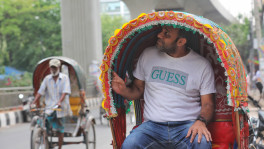Covid-19 impacts may double poverty in Bangladesh, says think tank

Impacts of the Covid-19 pandemic is threatening to bring back Bangladesh's poverty rate to a level the country had 15 years ago, according to a research report.
Bangladesh had a poverty rate of 40 percent in 2005.
The report further said the negative income shocks due to the pandemic will push the country's poverty rate to 40.9 percent, which is exactly the double of the present poverty at 20.5 percent.
The South Asian Network on Economic Modeling (SANEM), led by the think tank's Executive Director Dr Selim Raihan, revealed this on Friday in its assessment on poverty impacts of the Covid-19 pandemic in Bangladesh.
In addition to 3.4 crore existing poor, according to the SANEM research, in case of uplifting the poverty line income by 1.25 times, there are another 3.6 crore people who are "non-poor" but can be categorised as vulnerable population.
Using the latest Household Income and Expenditure Survey (HIES) data of the Bangladesh Bureau of Statistics, the researchers ran simulations, which revealed that with a negative income shock of 25 percent, the overall poverty rate will be 40.9 percent, meaning that another 20.4 percent population will fall into poverty.
The think-tank found that poverty impact of any income shock can differ depending on the people engaged in various economic activities.
Research results suggest that 43 percent of the newly poor in Bangladesh will be concentrated in economic activities like crop, animal and fishing production, 16 percent in different manufacturing activities including the RMG (readymade garment), 11 percent in retail trade, 10 percent in transport activities, and 7 percent in construction activities.
Given that the majority of these people are employed in informal activities, any employment shock, as in the Covid-19 crisis, is feared to have severe implications to the overall level of poverty of the country, SANEM said.
The report found that the poverty level will deepen more in some areas than others.
For example, in Rangamati, there will be an additional 30.9 percent people falling into poverty, Mymensingh 30.2 percent, Sunamganj 28.7 percent, Cox's Bazar 27.5 percent, Nilphamari 27.2 percent, Narail 27.1 percent, Chattogram 26.9 percent, Netrokona 25.9 percent, Chuadanga 25.8 percent, Sherpur 25.6 percent, Barguna 25.5 percent and Shariatpur 25.3 percent.
According to SANEM, the estimated impact is found to be lower in Dhaka, Narayanganj, Gazipur, Munshiganj, Brahmanbaria and Narsingdi.
However, since the initial hotspots of infections are concentrated in many of these areas with a high density of population, in reality, fall in income of households in these regions can be much higher than SANEM's assumption of 25 percent income shock.
Also, the higher concentration of small-scale trading activities, which can be heavily hit by the lockdown, may result in much more depressing impacts than the aforementioned estimations, it said.
The think-tank also welcomed the government for taking stimulus packages and social protection programmes to save the poor.
However, the success of these initiatives depends on three factors – effectively identifying the vulnerable people and thereby determining the nature and duration of support, ensuring that the genuinely affected industries and poor and vulnerable people receive support, and introducing a monitoring and evaluation mechanism to ensure efficiency, transparency and accountability in the distribution mechanism.


 Keep updated, follow The Business Standard's Google news channel
Keep updated, follow The Business Standard's Google news channel














